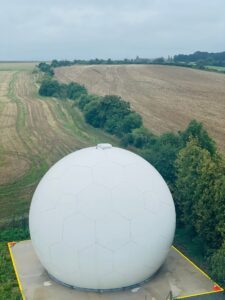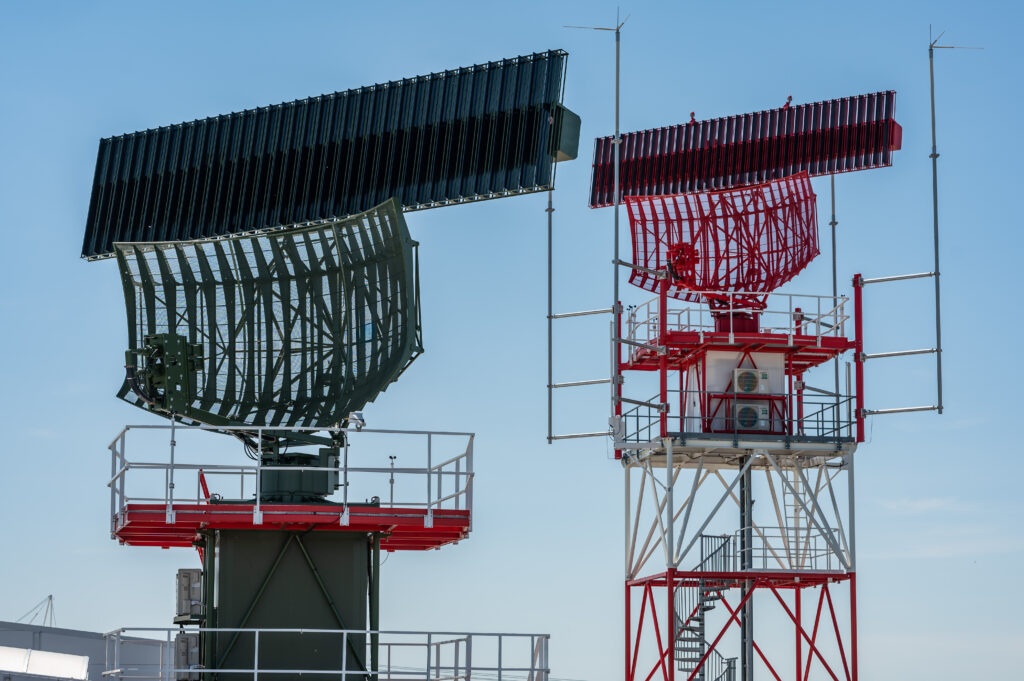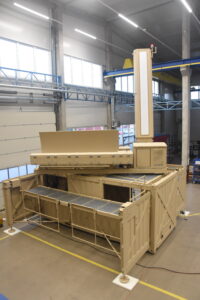Where radiomagnetic technology meets the future
ELDIS Pardubice, s.r.o., is a company with a rich history and a strong focus on the development and production of radar technology and air traffic control systems. Founded in July 1991 by former employees of the Institute of Radiotechnology, which was part of the renowned TESLA Pardubice, the company’s primary goal was to carry forward the legacy of TESLA and pursue the dream of developing and manufacturing their radar systems. Over the years, ELDIS has firmly established itself as a key player in the field.
The company is at the forefront of radar technology and air traffic control systems. Their core activities encompass the full spectrum of radar system development, from initial design to manufacturing. With a highly skilled team of specialists, ELDIS conducts in-depth problem analysis, feasibility studies, efficient project management, and the meticulous development of circuits and software. Their expertise extends to electrical and mechanical engineering, ensuring the highest quality standards. From comprehensive functional testing to seamless equipment installation, ELDIS delivers integrated solutions that go beyond national borders. Their products, including the Primary Surveillance Radar RL-2000 (Editor’s note: Active radar system for precise aircraft tracking based on emitted and reflected radio waves.), Secondary Surveillance Radar MSSR-1 (Editor’s note: Complements primary radar with aircraft identification and altitude data using active interrogation.), and Precision Approach Radar PAR-E (Editor’s note: Active radar aiding safe aircraft takeoff and landing by providing altitude and position data.), form the RPL-2000 radar set, offering complete solutions for Air Traffic Control and Air Defense needs. These innovative systems are not confined to the Czech Republic; they serve over twenty-five countries worldwide, exemplifying ELDIS’s global reach and impact in the field of radar technology.
ELDIS Pardubice, s.r.o., is a proud member of the industrial group CZECHOSLOVAK GROUP and its aerospace division, CSG Aerospace.
This article sheds light on the fascinating journey of ELDIS Pardubice, s.r.o., and its Technical Director, Tomáš Müller, and their dedication to advancing radiomagnetic technology. Müller’s story is intertwined with the company’s evolution, reflecting his deep-rooted belief that “Knowledge is the only freedom of man.” Together, they continue to push the boundaries of radar technology and contribute to the global aerospace industry.
Müller’s story began not in Pardubice but in Silesia, near Opava. It was a childhood dream to become a soldier, and in 1991, his journey led him to the Military Academy in Brno. There, under the tutelage of František Beer, a renowned figure born in 1935 and an author of significant publications on radiolocation and navigation technology, Müller cultivated his passion. It was during this period of immense change that Müller, charged with active radar operations, delved into the realm of the ‘electronic war.’
During his tenure at the Military Academy, the institution incorporated subjects on passive systems, introducing students to devices like Tamara, a predecessor to modern equipment such as Vera. Müller’s dedication saw him climb ranks – from a technician to the leader of a radar troop, eventually becoming the deputy commander of a radio technical battalion. By 38, he held the rank of Major. Today, units from this battalion are being re-equipped with MADR (Mobile Air Defense Radar), garnering media attention.
After two decades of military service, Müller, in 2011, sought a fresh challenge. Transitioning from the armed forces to the civilian sector was challenging. Still, his proficiency in English propelled him into roles that required direct communication with customers in international companies, providing invaluable experience. Yet, his heart yearned for his initial passion, leading him back to the realm of radiotechnology with ELDIS.
Now at ELDIS for over two years, Müller speaks of accomplishments like the development of the Radom. Collaborating with the University of Pardubice and NST, the decision to persist with the Radom project has proved fruitful. This state-of-the-art structure is a delicate balance between weight and durability against winds and hail. Originally designed to complement their combined radar, the Radom now offers a comprehensive one-stop solution for potential clients.

The new Radom from Eldis.
Discussing the present and future of radar technology, Müller notes the emergence of coherent locators with integrated transceivers. This innovative approach ensures the radar’s seamless function. ELDIS, adapting to this technological evolution, shifted from traditional silicon technology to gallium-nitride technology (Editor’s note: Gallium-Nitride (GaN) technology represents a substantial leap in radar technology. GaN technology is known for its exceptional thermal stability at high temperatures, making it well-suited for radar applications. It enhances radar transmission and reception efficiency while concurrently reducing energy consumption.) for their end amplifiers, enhancing stability at higher temperatures and ensuring efficient functioning in transmission. This transition rendered ELDIS’s radar as a software-defined entity, where most functions are now driven by advanced software. Interestingly, in comparison to the earlier bulky radar systems which required multiple units, today’s radars are sleek, compact, and increasingly software-centric. For Müller, watching software engineers take the forefront in this domain has been nothing short of remarkable.

Combined radars from Eldis.
ELDIS’s radar systems, especially the NG series, embody this software-driven philosophy. The software not only drives these radars but also self-diagnoses remotely, predicting future malfunctions. This blend of minimized hardware, decreased energy consumption, and advanced software diagnostic capabilities, positions ELDIS at the forefront of global trends. In collaboration with the University of Pardubice, the aspiration now is to simulate both software and hardware completely, bringing the concept of a ‘digital twin’ (Editor’s note: Virtual representation of both software and hardware for simulations, insights, and optimizations in radar system development and maintenance.) to fruition, providing comprehensive insights and optimizations.

New precision approach radar for a German customer
Operating within the larger framework of the CZECHOSLOVAK GROUP and its CSG Aerospace division, ELDIS stands proud with about 260 members. In collaboration with Retia, another firm within the CSG umbrella, their strength amplifies to 520. Zooming out to the CSG Aerospace group, the number scales up to 1,100. Yet, in the vast radar technology realm dominated by giants, ELDIS leverages the agility and responsiveness of a smaller entity.
Müller’s pride in ELDIS’s flexibility and adaptability was evident when he mentioned, “Being a smaller player, our strength lies in our adaptability and our ability to tailor our solutions to the specific desires of our customers.” During the pandemic, when supply chains were disrupted, causing market panic, Müller praises his employees, “They, at the risk of their personal freedom, traveled abroad and installed orders under challenging circumstances.”
Now, Müller discusses the company’s ambitious venture into 3D radar technology. “The concept of phased radars has been around for maybe 50 years. Even though they were analog, these locators worked. The primary challenge with these software-controlled 3D radars is processing an immense amount of data in the shortest time, as this is crucial for measurement accuracy. Any delay introduces an error,” he says. Müller highlights that ELDIS is no stranger to this technology. “In the past, we supplied the Czech army with radars that utilized active electronic scanned arrays. What the mechanics did previously is now handled by electronics.”
3D radars, as Müller elucidates, offer a comprehensive understanding of the airspace or battlefield by measuring data in three dimensions: range, azimuth, and elevation. This contrasts with traditional 2D radars that provide data on range and azimuth but not elevation.
Müller, with evident excitement, remarks, “We are continuously working on advancing our 3D radar technology and aim to launch it into the market once it meets our standards of excellence. The possibilities for its application are broad and significant, covering everything from civil aviation safety to advanced military strategies.”
As ELDIS looks to the future, innovation is at the forefront. Müller touches upon the importance of data fusion – combining data from various sources to create a coherent, comprehensive understanding of the environment. “With the proliferation of sensors in today’s world, whether they be radars, cameras, or other detectors, there’s a wealth of data available. Our challenge and opportunity lie in effectively merging this data to provide an unparalleled situational awareness,” he explains.
Moreover, he highlights the advancements in artificial intelligence (AI) and machine learning (ML) and their integration into radar systems. “AI and ML can help us sift through the vast amounts of data our radars capture, filtering out noise and identifying patterns and threats with greater accuracy. These technologies can significantly reduce the cognitive load on operators and improve decision-making processes.”
Highlighting ELDIS’s dedication to sustainability, Müller emphasizes the company’s efforts to minimize its carbon footprint. “As we develop our next-generation radar systems, we prioritize energy efficiency and environmental concerns. Naturally, as these devices are significantly smaller, they logically have reduced energy consumption,” he explains.
Reflecting on his journey, from the military to the helm of technical operations at ELDIS, Müller expresses immense gratitude. “Witnessing the leaps in radiomagnetic technology and playing a part in its evolution has been incredibly fulfilling.”
He also emphasizes the value of collaboration and partnerships. “Our association with institutions like technical universities and companies under the CSG Aerospace umbrella amplifies our capabilities. When we come together with a shared vision, the possibilities are boundless.”
As we consider the strategic priorities of ELDIS Pardubice, s.r.o. for the next 3-5 years, the focus is sharply defined: to advance 3D radar technology, to improve mobility, and to incorporate multisensory systems that are set to transform radar usage. A significant factor in this progressive agenda is the unwavering commitment and skill of the 84-strong technical team. The company deeply values their meticulous work which is the engine driving these technological strides.
In tandem with Tomáš Müller’s insight that knowledge liberates, the company is poised to explore beyond the current horizons of radar capabilities. The combined force of Müller’s foresight and the technical team’s expertise assures that the company’s trajectory is aimed at a future rich with practical innovation and real-world applications.
Written and edited: Katerina Urbanova, EIC @ ACE
Photo credit: Eldis Pardubice
- SEO Powered Content & PR Distribution. Get Amplified Today.
- PlatoData.Network Vertical Generative Ai. Empower Yourself. Access Here.
- PlatoAiStream. Web3 Intelligence. Knowledge Amplified. Access Here.
- PlatoESG. Carbon, CleanTech, Energy, Environment, Solar, Waste Management. Access Here.
- PlatoHealth. Biotech and Clinical Trials Intelligence. Access Here.
- Source: https://aero-space.eu/2023/11/10/eldis-pardubice-shaping-the-skies-with-next-gen-radar/



